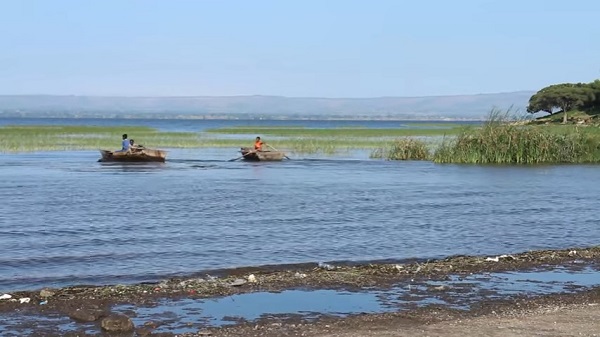
Various tasks, by different groups, have been carried out to prevent Lake Hawassa from such siltation, over exploitation of fish and dumping of wastes, and rescue biodiversity.
By Girmachew Gashaw (The Ethiopian Herald)
Following the ecological threat of Lake Hawassa, which is a habitat for enormous aquatic animals and a livelihood for a number of people, stakeholders are striving to rescue the lake from drying.
Indeed, the issue is real. As concerned professionals and stakeholders uttered, ‘the Lake is in great trouble’!.
Hawassa University Biology Department Head Dr. Girma Tilahun said it is unthinkable to see Hawassa town with the absence of Lake Hawassa. However, the speedy expansion of township, industry and tourism development are putting the lake in danger.
Irrefutably, expansion of industries, township and tourism are sources of economic growth that can not be put aside, but designing a mechanism that enables to execute both side by side, with out causing any harm is, imperative.
Mentioning that he has been conducting various studies on rift-valley lakes, Dr. Girma said the land which is holding water and serving as a source of water is now declining due to the expansion of the town. The pollution of the lake is also intensified as the town expands. For instance, ‘Cheleleke Lake’ which was 14.5 square kilo meters deep some 40 years ago, has now shown a great decline and reached below 100 meter square approaching to dry out, he elucidated.”
The Lake, which was once a tributary for Lake Hawassa, has become invisible these days to take its picture from satellite.
The Hawassa University has begun various activities to rescue the Lake. It has been conducting researches. “If we pay little attention on the matter and hesitate to act, we could not end the sacrifice it requires,” said Dr. Girma adding that “We have to work carefully to address the problem. The studies should be conducted in an organized manner. For this to happen, coordination is critical. The threat is already there. The supervision and follow-up work should also be sustained steadily. What is more, such a task requires performing tasks at the grass root level.”
Andinet Youth Recreational Association earns its income through serving fried fish for tourists, Chairman of the Association Temesgen Wolka said. The lake is serving as means of living for hundreds of people that the ecological threat of the lake risks those people.
Lake Hawassa Lovers Association President Professor Zinabu Gebremariam also said that the protection and conservation tasks of the lake are not left to the government alone. “The society should highly participate on the matter. The Association is established with a mission of serving as a bridge between the government and the public at large,” he said.
According to the President, the Association will mobilize the public and provide advice to government about the lake. Its vision is to restore the lake to its previous condition, and make it a conducive environment for biodiversity.
South Nations Nationalities and Peoples State Environment Protection Authority General Director Samuel Qeqebo on his behalf said that, various tasks have been carried out to prevent the lake from such siltation, over exploitation of fish and dumping of wastes, and rescue biodiversity.
Underscoring that efforts have been made in collaboration with Rift Valley Lakes Irrigation Authority and the Oromia State Government to prevent land degradation, he said adding that implementation of the solution requires coordinated efforts of all stockholders.
Source: The Ethiopian Herald
——
Other stories:
- Study: Lake Abaya and Lake Chamo on the Brink of Jeopardy
- AAU Organizes National Conference on Threats to Lake Ziway
